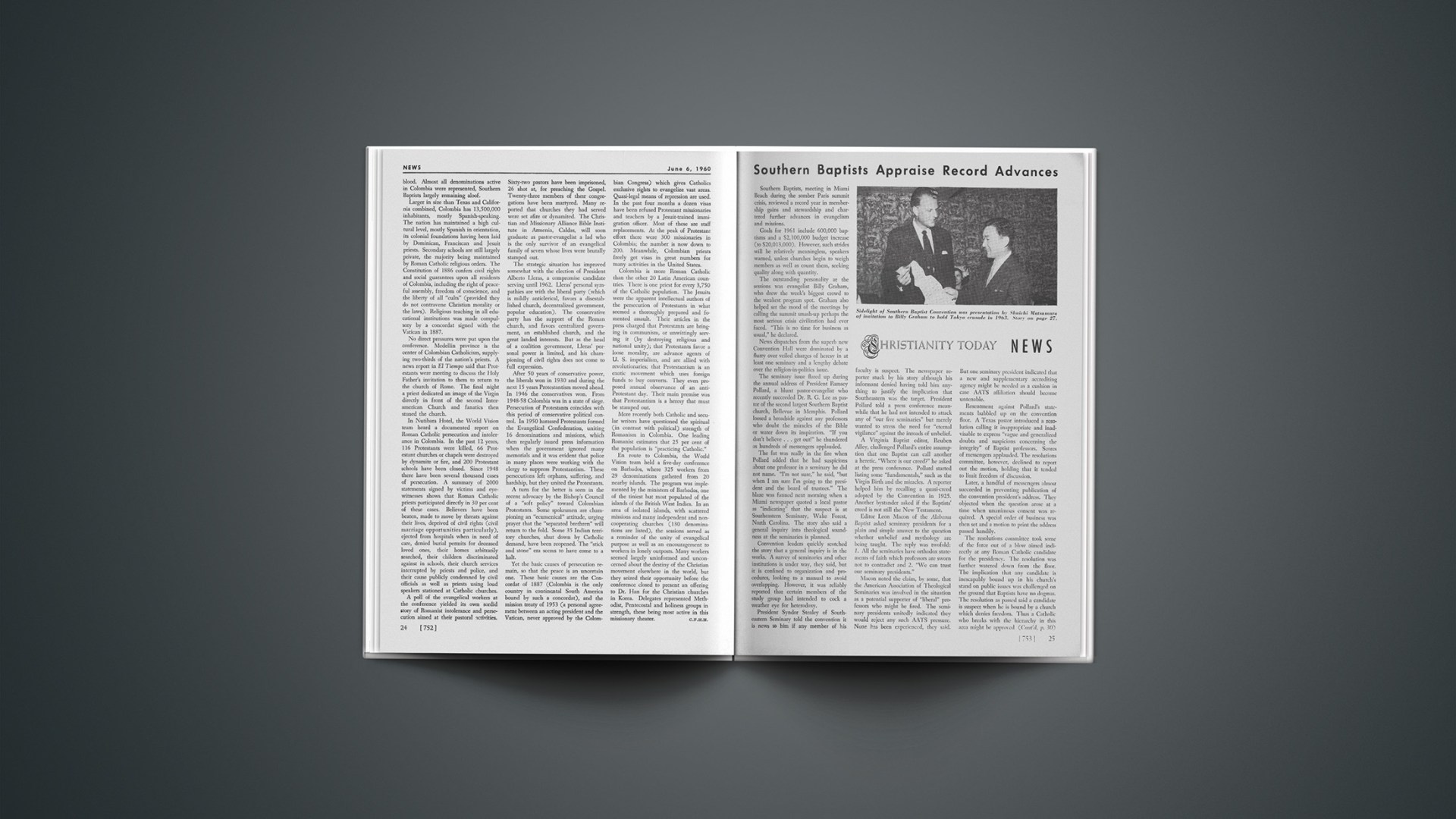Gathering 350 pastors and workers from Colombia, Venezuela and Ecuador, an epochal World Vision conference May 9–13 prodded evangelical forces to a deeper sense of their spiritual task in a time of unrest in Latin America. In the newly completed auditorium of the Interamerican Mission Seminary campus in Medellín (second in size to Colombia’s capital city in Bogotá), delegates heard Dr. Bob Pierce, Dr. Paul Rees, Dr. Kyung Chik Han of Korea, and Editor Carl F. H. Henry of CHRISTIANITY TODAY press the burning relevance of the Gospel to the plight of modern man and contemporary culture.
Colombia has been a center of Romanist repression, and not infrequently of persecution, of Protestant missionary effort.
Chafing under press reports of Romanist intolerance, spokesmen for the U. S. Catholic church, steadily expanding a drive for political power, have commented ambivalently. Some have waved aside the accounts as “mere propaganda”; others have deplored the tendency of Protestants to identify Romanism with “Spanish Christianity” (without themselves repudiating it); others have spoken of religious liberty as a proper expectation by non-Romanists.
Evangelical workers in Latin America have steadily sharpened their evangelistic focus, aware that Roman strategy changes frequently. Colombia today has the fastest growing evangelical population in the world. In Medellín the 350 delegates included 30 from Western Venezuela and 30 from Ecuador; the others were from Colombia (50 missionaries, 240 nationals). This was more than four times the number of full-time Protestant workers ever gathered in assembly in Colombia. Roman Catholic persecution has purified the Church and stimulated growth. Baptized church members increased 51 per cent during the five worst years of persecution, and the Protestant community now numbers about one per cent of the population. A survey of evangelical work in Colombia by the Evangelical Confederation and the National Pastors’ Conference now shows 192 organized Protestant Spanish-speaking churches, 401 congregations with regular services, 119 Protestant-sponsored schools, 22 hospitals, dispensaries or clinics, and 13 seminaries or Bible institutes. But there is still only one worker for every 24,000 inhabitants.
World Vision arrangements were implemented by the Rev. Robert W. Lazear, Jr., of Bogotá, executive secretary of the Evangelical Confederation, and the Rev. Bert Biddulph, rector of the Interamerican Seminary in Medellín. Following the conference, the seminary dedicated its new building—a gift of World Vision—and carried on another week with study courses. The background, education and intellectual level of Colombian pastors are extremely varied, from rural worker to city pastor. Cultural background too is varied, with diverse mixtures of Spanish, Indian and Negro blood. Almost all denominations active in Colombia were represented, Southern Baptists largely remaining aloof.
Larger in size than Texas and California combined, Colombia has 13,500,000 inhabitants, mostly Spanish-speaking. The nation has maintained a high cultural level, mostly Spanish in orientation, its colonial foundations having been laid by Dominican, Franciscan and Jesuit priests. Secondary schools are still largely private, the majority being maintained by Roman Catholic religious orders. The Constitution of 1886 confers civil rights and social guarantees upon all residents of Colombia, including the right of peaceful assembly, freedom of conscience, and the liberty of all “cults” (provided they do not contravene Christian morality or the laws). Religious teaching in all educational institutions was made compulsory by a concordat signed with the Vatican in 1887.
No direct pressures were put upon the conference. Medellín province is the center of Colombian Catholicism, supplying two-thirds of the nation’s priests. A news report in El Tiempo said that Protestants were meeting to discuss the Holy Father’s invitation to them to return to the church of Rome. The final night a priest dedicated an image of the Virgin directly in front of the second Interamerican Church and fanatics then stoned the church.
In Nutibara Hotel, the World Vision team heard a documented report on Roman Catholic persecution and intolerance in Colombia. In the past 12 years, 116 Protestants were killed, 66 Protestant churches or chapels were destroyed by dynamite or fire, and 200 Protestant schools have been closed. Since 1948 there have been several thousand cases of persecution. A summary of 2000 statements signed by victims and eye-witnesses shows that Roman Catholic priests participated directly in 30 per cent of these cases. Believers have been beaten, made to move by threats against their lives, deprived of civil rights (civil marriage opportunities particularly), ejected from hospitals when in need of care, denied burial permits for deceased loved ones, their homes arbitrarily searched, their children discriminated against in schools, their church services interrupted by priests and police, and their cause publicly condemned by civil officials as well as priests using loud speakers stationed at Catholic churches.
A poll of the evangelical workers at the conference yielded its own sordid story of Romanist intolerance and persecution aimed at their pastoral activities. Sixty-two pastors have been imprisoned, 26 shot at, for preaching the Gospel. Twenty-three members of their congregations have been martyred. Many reported that churches they had served were set afire or dynamited. The Christian and Missionary Alliance Bible Institute in Armenia, Caldas, will soon graduate as pastor-evangelist a lad who is the only survivor of an evangelical family of seven whose lives were brutally stamped out.
The strategic situation has improved somewhat with the election of President Alberto Lleras, a compromise candidate serving until 1962. Lleras’ personal sympathies are with the liberal party (which is mildly anticlerical, favors a disestablished church, decentralized government, popular education). The conservative party has the support of the Roman church, and favors centralized government, an established church, and the great landed interests. But as the head of a coalition government, Lleras’ personal power is limited, and his championing of civil rights does not come to full expression.
After 50 years of conservative power, the liberals won in 1930 and during the next 15 years Protestantism moved ahead. In 1946 the conservatives won. From 1948–58 Colombia was in a state of siege. Persecution of Protestants coincides with this period of conservative political control. In 1950 harassed Protestants formed the Evangelical Confederation, uniting 16 denominations and missions, which then regularly issued press information when the government ignored many memorials and it was evident that police in many places were working with the clergy to suppress Protestantism. These persecutions left orphans, suffering, and hardship, but they united the Protestants.
A turn for the better is seen in the recent advocacy by the Bishop’s Council of a “soft policy” toward Colombian Protestants. Some spokesmen are championing an “ecumenical” attitude, urging prayer that the “separated brethren” will return to the fold. Some 35 Indian territory churches, shut down by Catholic demand, have been reopened. The “stick and stone” era seems to have come to a halt.
Yet the basic causes of persecution remain, so that the peace is an uncertain one. These basic causes are the Concordat of 1887 (Colombia is the only country in continental South America bound by such a concordat), and the mission treaty of 1953 (a personal agreement between an acting president and the Vatican, never approved by the Colombian Congress) which gives Catholics exclusive rights to evangelize vast areas. Quasi-legal means of repression are used. In the past four months a dozen visas have been refused Protestant missionaries and teachers by a Jesuit-trained immigration officer. Most of these are staff replacements. At the peak of Protestant effort there were 300 missionaries in Colombia; the number is now down to 200. Meanwhile, Colombian priests freely get visas in great numbers for many activities in the United States.
Colombia is more Roman Catholic than the other 20 Latin American countries. There is one priest for every 3,750 of the Catholic population. The Jesuits were the apparent intellectual authors of the persecution of Protestants in what seemed a thoroughly prepared and fomented assault. Their articles in the press charged that Protestants are bringing in communism, or unwittingly serving it (by destroying religious and national unity); that Protestants favor a loose morality, are advance agents of U. S. imperialism, and are allied with revolutionaries; that Protestantism is an exotic movement which uses foreign funds to buy converts. They even proposed annual observance of an anti-Protestant day. Their main premise was that Protestantism is a heresy that must be stamped out.
More recently both Catholic and secular writers have questioned the spiritual (in contrast with political) strength of Romanism in Colombia. One leading Romanist estimates that 25 per cent of the population is “practicing Catholic.”
En route to Colombia, the World Vision team held a five-day conference on Barbados, where 325 workers from 29 denominations gathered from 20 nearby islands. The program was implemented by the ministers of Barbados, one of the tiniest but most populated of the islands of the British West Indies. In an area of isolated islands, with scattered missions and many independent and non-cooperating churches (130 denominations are listed), the sessions served as a reminder of the unity of evangelical purpose as well as an encouragement to workers in lonely outposts. Many workers seemed largely uninformed and unconcerned about the destiny of the Christian movement elsewhere in the world, but they seized their opportunity before the conference closed to present an offering to Dr. Han for the Christian churches in Korea. Delegates represented Methodist, Pentecostal and holiness groups in strength, these being most active in this missionary theater.










